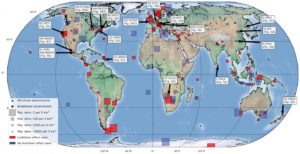
Citizen Science Data Helps to Unearth Seismic Noise Reduction from COVID-19

The COVID-19 pandemic has had an enormous chilling effect on global society. For months, everything from shopping to traffic slowed around the world, and people even began noticing measurable changes in wildlife populations and pollution levels. Now, data from a citizen science project is helping researchers examine another aspect of COVID-19’s planetary quieting: seismic noise.
Seismic noise is the passive, constant hum in the ground produced by human activity on Earth – traffic, transit, walking, construction, and so on. For months, several hundred seismic stations across 78 countries have been carefully monitoring this seismic noise as the pandemic swept across the globe.

The global seismic stations used in the study. Lockdown effects are shown in red. Image courtesy of the authors.
These seismic stations included 65 Raspberry Shake seismographs: devices built on top of single-board Raspberry Pi computers and designed to monitor seismic activity at home or in the classroom. Raspberry Shake claims that these citizen science devices constitute the “largest singular network of real-time seismographs in the world” (to see a map of those citizen seismographs, click here).
Lead author Thomas Lecocq of the Royal Observatory of Belgium organized an academic collaboration involving 76 authors from 66 institutions and 27 countries to sort through the many terabytes of data produced by these seismographs. The authors were able to pin down the startling scale of the change: the lockdowns had reduced seismic noise by 50% worldwide, despite no statistical change in the amount of non-anthropogenic seismic activity.
This staggering halving of the ambient noise produced by humans represented the largest such reduction on record, and the reduction was so dramatic that it could be detected on sensors buried hundreds of meters into the ground in sub-Saharan Africa. To confirm the relationship between the lockdowns and the noise reduction, the authors correlated the seismic noise levels with mobility data provided by tech companies like Apple and Google that have been publishing anonymized movement data from smartphones throughout the pandemic.
“This is a great example of the type of role citizen seismology can play in contributing to the scientific record,” said Ian Nesbitt, Raspberry Shake’s chief scientist . “We are very proud of our community’s involvement in this unique study.”
The authors hope that this will be the first of many studies examining the seismic effects of reduced human activity during COVID-19-induced lockdowns, particularly for use as a proxy to human activity without infringing on privacy concerns. Next, the authors are looking to identify previously hidden seismic signals from earthquakes and volcanoes to further isolate the seismic signals produced by human activity.



























